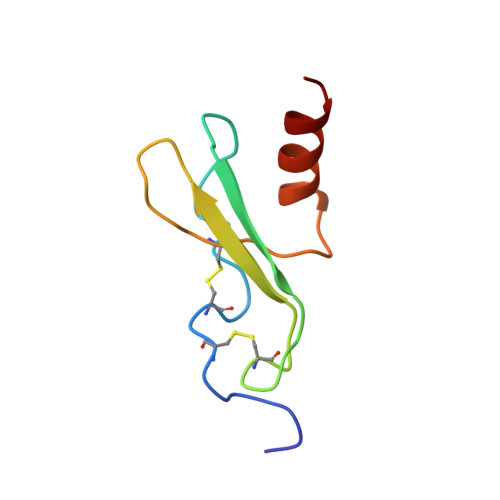NMR solution structure of the 32-kDa platelet factor 4 ELR-motif N-terminal chimera: a symmetric tetramer.
Mayo, K.H., Roongta, V., Ilyina, E., Milius, R., Barker, S., Quinlan, C., La Rosa, G., Daly, T.J.(1995) Biochemistry 34: 11399-11409
- PubMed: 7547867
- DOI: https://doi.org/10.1021/bi00036a012
- Primary Citation of Related Structures:
1PFM, 1PFN - PubMed Abstract:
Native human platelet factor 4 (PF4) is a homotetrameric protein (70 residues/subunit) known for its anticoagulant heparin binding activity. 2D 15N--1H HSQC NMR experiments of native PF4 in solution show the presence of conformational heterogeneity consistent with the formation of asymmetric homo-tetramers as observed in the X-ray crystal structure of both human and bovine PF4. A chimeric mutant of PF4 (called PF4-M2) which substitutes the first 11 N-terminal residues for the first eight residues from homologous interleukin-8 forms symmetric homo-tetramers with essentially the same heparin binding activity as native PF4. The solution structure of PF4-M2 has been investigated by using two- and three-dimensional 1H- and 15N-NMR spectroscopy and NOE-restrained simulated annealing molecular dynamics. As with other members of the CXC chemokine family whose structures are known, the PF4-M2 subunit monomer consists of a mostly hydrophobic, triple-stranded antiparallel beta-sheet onto which is folded an amphipathic C-terminal helix and a less periodic N-terminal domain. Although N-terminal substitution with the less acidic interleukin-8 sequence most affects the quarternary structure relative to native PF4 at the AC and AD dimer interfaces, AB dimer stability is weakened as reflected in reduced equilibrium association binding constants.
Organizational Affiliation:
Department of Biochemistry, University of Minnesota, Minneapolis 55455, USA.














